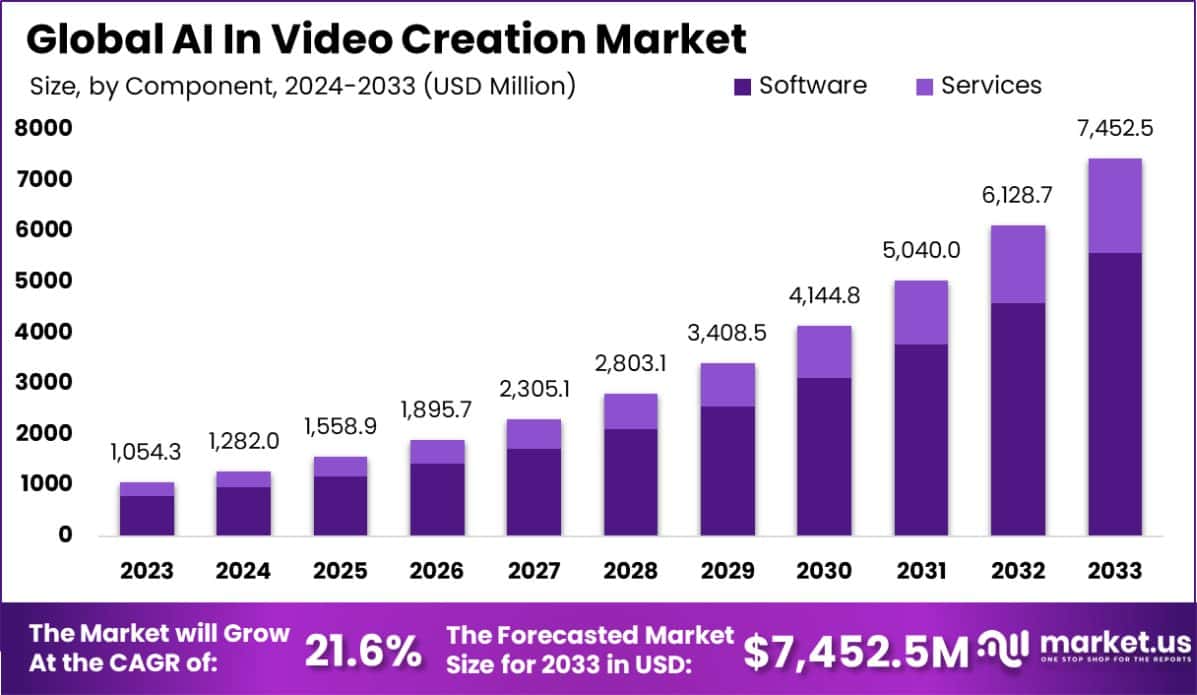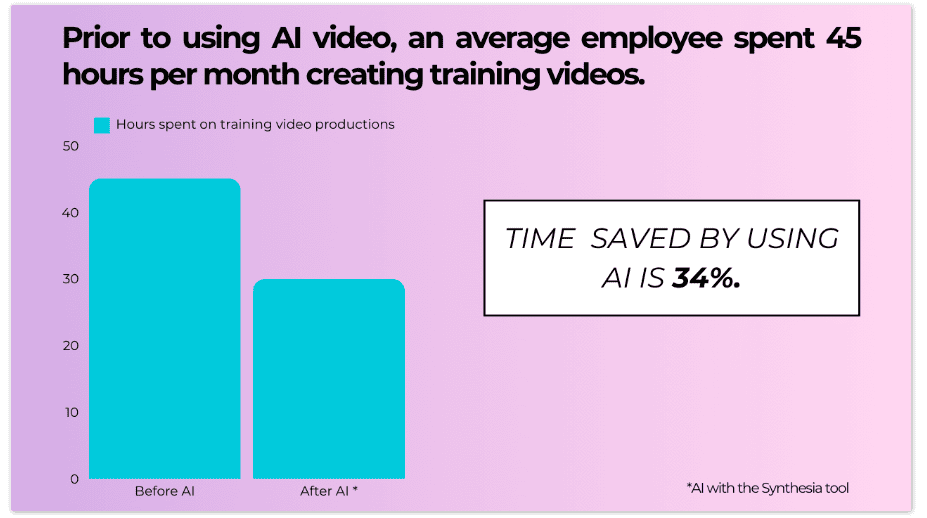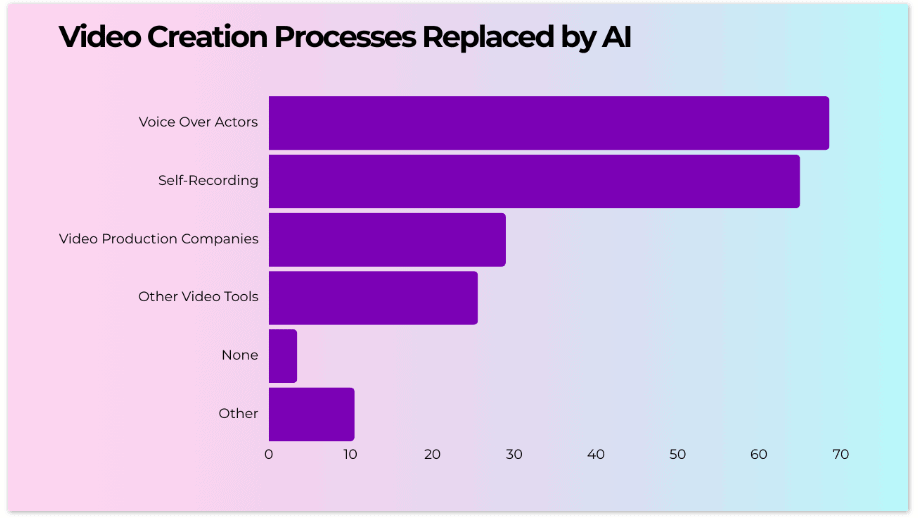Table of Contents
Introduction
The worldwide market for AI in Video Creation is projected to grow from USD 1,054.3 million in 2023 to approximately USD 7,452.5 million by 2033. This represents a compound annual growth rate (CAGR) of 21.6% from 2024 to 2033. AI in video creation is revolutionizing the way digital content is produced, enabling faster and more efficient processes compared to traditional methods. This technology leverages machine learning algorithms to automate various aspects of video production, such as editing, animation, and effects generation, thus reducing the need for extensive human intervention.
There is a growing demand for AI in video creation, primarily driven by the increasing consumption of video content across various platforms. As brands and individuals look to differentiate their video offerings in a crowded digital space, AI technologies that can provide unique, engaging, and high-quality content quickly are especially sought after. Additionally, the expansion of video marketing and the need for cost-effective production methods are further boosting the demand for AI-enabled video creation tools.

The growth prospects for the AI video creation market are robust, with advancements in AI technology and increasing accessibility through cloud-based platforms. As AI tools become more sophisticated, they are capable of handling more complex video production tasks, further integrating into mainstream production workflows. This growth is supported by the expansion of digital infrastructure and the broader adoption of AI across various sectors.
Opportunities within the AI video creation market are vast as there is significant potential for development in areas such as real-time video editing, AI-driven animation, and personalized video content generation. Additionally, as technology evolves, there is an opportunity for AI to play a larger role in creative decision-making processes, providing insights based on data analytics to guide content creation. This integration of AI not only streamlines production but also enhances the creative capabilities of video creators, opening up new possibilities for innovative video content.
Key Takeaways
- In 2023, the Software component held over 75% of the market share in the AI in Video Creation market.
- The Cloud deployment model dominated the AI in Video Creation market in 2023, securing more than 63% of the market share.
- Content Creation led the Application segment of the AI in Video Creation market in 2023, with more than a 35% market share.
- In the end-user Industry segment, Media and Entertainment held the largest market share of over 32% in the AI in Video Creation market in 2023.
- North America was the leading region in the AI in Video Creation market in 2023, with a 38% market share and generating USD 400.63 million in revenue
AI In Video Creation Statistics
- The Generative AI in Video Creation Market is on a significant upward trajectory. It is projected to reach a market size of approximately USD 2.3 billion by 2033, demonstrating robust growth. This expansion is characterized by a compound annual growth rate (CAGR) of 21.2% from 2024 to 2033, reflecting the increasing adoption and integration of generative AI technologies in video production across various industries
- AI tools can significantly enhance efficiency in video production. On average, AI tools can save up to 62% of the time required to produce training videos, which translates to approximately 8 days per month. Furthermore, employees report a time saving of about 34%, or 45 hours per month, when using AI video production tools.
- The integration of AI in video marketing is becoming increasingly popular. Around 75% of video marketers have already adopted AI to assist in content creation. Moreover, 42% of Learning & Development managers have transitioned from traditional video production methods to AI-based solutions, reflecting a robust shift towards these technologies.
- Financial efficiency is another significant benefit of AI video tools. These tools are capable of reducing production costs by 44.1%, offering a substantial cost advantage to organizations.
- Consumer acceptance of AI is also on the rise. Approximately 52% of consumers feel comfortable using AI-driven assistance on digital channels, indicating growing trust and reliance on AI technologies in consumer interactions.
- AI-powered video creation tools have dramatically shifted the landscape of video production, offering a reduction in time and budget by up to 80% compared to traditional methods.
- The broader AI video production market also reflects significant growth potential, projected to experience a CAGR of 22.37% by 2028. This growth highlights the increasing reliance on AI to produce engaging video content that captivates audiences effectively.
- In the realm of employee skill development and information retention, 97% of respondents recognize video as an effective medium, emphasizing its pivotal role in learning and development (L&D) strategies. This sentiment is echoed by 97% of L&D professionals who believe video to be more effective than text-based documents for training purposes.
- Organizational L&D strategies are increasingly incorporating video due to its effectiveness, with 98% of respondents affirming its crucial role. The adoption of video varies across formats, with 65% utilizing presentations, 40% employing explainer videos, 32% for product demos, and nearly 50% for testimonials, indicating a diverse application of video content in marketing and educational contexts.
- Furthermore, 43% of respondents report that AI tools have already replaced traditional video production processes within their organizations, signifying a shift towards more efficient, technologically driven production methods. This transition not only enhances content quality but also streamlines the production process, aligning with modern needs for rapid, cost-effective video creation.


Source: vidjet.com
Efficiency and Cost Reduction
- The integration of AI-powered video creation tools has emerged as a pivotal factor in enhancing production efficiency, reducing both time and budget requirements by up to 80% compared to traditional video production methods. This substantial reduction in resource allocation not only streamlines production processes but also empowers businesses to reallocate their financial and human resources more strategically towards other critical marketing endeavors.
- In the realm of training video production, the impact of AI tools is particularly notable. Since their adoption, the average production time has decreased from 13 days to merely 5 days, equating to a 62% reduction. This significant enhancement in production speed underscores the transformative potential of AI technologies in optimizing the operational efficiencies of Learning and Development (L&D) teams.
Adoption and Usage
- The integration of Artificial Intelligence (AI) in video content creation is becoming increasingly prevalent within the marketing sector. Approximately 75% of video marketers have adopted AI technologies to enhance their content creation processes. This significant adoption rate underscores a broad acceptance and reliance on AI tools to streamline production, enhance creativity, and increase efficiency in video marketing strategies.
- Furthermore, the pivotal role of video content extends into the realm of learning and development (L&D). An overwhelming 98% of L&D professionals affirm that video is indispensable for their organization’s training strategies.
- The effectiveness of video over traditional text-based documents is notable, with 97% of professionals agreeing that video significantly improves information retention. This data underscores the critical role that video content plays in educational and training environments, highlighting its superior efficacy in engaging audiences and facilitating a deeper understanding of complex topics.
Emerging Trends
- Avatar Actors and Likeness Licensing: AI is enabling the use of digital avatars created from licensed likenesses, offering a cost-effective alternative to traditional video shoots. This technology allows marketers to generate diverse content quickly, leveraging AI to handle variations in presentation and dialogue without the need for physical actor presence.
- Authenticity Over High Production: There’s a growing preference for videos that appear more authentic and less polished. This trend is driven by the shift in consumer engagement, where viewers favor content that feels genuine and relatable, particularly on platforms like TikTok and Instagram.
- Video Personalization: Hyper-personalized video content is becoming essential, with AI tools enabling customization based on viewer data to enhance relevance and engagement. This includes altering content dynamically based on user behavior or preferences.
- Rapid Content Iteration: AI is speeding up the video content creation process, allowing for quick iterations that adapt to feedback and analytics. This rapid cycle helps in refining marketing strategies and responding to trends with agility.
- Integration of AI in Video Editing Software: Cloud-based AI video editing tools are making it easier and more cost-effective for businesses to create professional-grade videos. These tools facilitate a wide range of video editing tasks that can be managed remotely, helping businesses scale their video production without substantial investments in specialized equipment.
Top Use Cases of AI in Video Creation
- Content Automation: AI is extensively used to automate various aspects of video production, from scriptwriting to editing. Tools like ChatGPT and Synthesia can generate video scripts and create digital avatars to narrate these scripts, effectively reducing the time and effort involved in content creation.
- Enhanced Creativity: AI opens up new creative possibilities, helping creators expand their visual and narrative scope. It can suggest unique content ideas or visual styles that might not be intuitive to human creators, thus enriching the creative process.
- Scalable Video Marketing: AI tools enable marketers to produce video content at scale, aligning with various marketing campaigns and strategies without the constant need for human input. This scalability is crucial for maintaining a consistent presence across multiple media channels.
- Interactive and Engaging Content: AI-driven tools are enhancing viewer engagement by creating interactive and personalized video experiences. For example, AI can modify video content in real-time to match viewer preferences or respond to interactive inputs during the viewing experience.
- Accessibility Enhancements: AI contributes significantly to making video content more accessible. Automatic subtitle generation, language translation, and content summarization are some of the key features that AI integrates into video content, expanding its reach to a broader audience.
Major Challenges
- Quality and Authenticity: While AI tools like Synthesia and Descript can generate video content rapidly, they often lack the nuanced emotional depth and realism that professional human actors and voice-over artists bring. The AI-generated avatars may appear life-like but can sometimes deliver performances that feel uncanny or slightly off, which might not always be suitable for every audience or brand.
- Limited Creativity and Flexibility: AI systems are typically bound by the data they were trained on, limiting their ability to produce content that goes beyond their initial programming. This can result in videos that lack originality or fail to capture the brand’s unique voice and tone.
- Technical and Ethical Concerns: The use of AI in video production raises significant ethical questions, particularly around the use of data and the potential for generating misleading or false information. There’s also the ongoing challenge of ensuring that AI-generated content adheres to copyright laws and does not inadvertently plagiarize existing materials.
- Dependency on Human Oversight: Despite advances, AI video creation tools still require significant human intervention to ensure quality and accuracy. The technology can support various aspects of production but cannot completely replace human creativity and decision-making capabilities.
- Economic and Employment Impacts: The integration of AI into video production could disrupt traditional jobs in the industry, raising concerns about job losses among traditional roles that could be automated by AI technologies.
Top Opportunities
- Cost Reduction and Efficiency: AI significantly reduces the costs and time associated with video production. Tools like Synthesia allow for the quick creation of ‘talking head’ videos and localization in multiple languages, which can be highly beneficial for businesses looking to scale their video marketing efforts without a corresponding increase in budget.
- Scalability: AI enables companies to scale their video production efforts as needed without the necessity for proportional increases in human resources. This scalability is crucial for businesses that need to ramp up their content output without compromising on turnaround times.
- Personalization: AI excels in creating personalized content by analyzing viewer data and preferences. This capability can lead to higher engagement rates and more effective marketing as content can be tailored to the specific tastes and interests of different audience segments.
- Innovative Content Formats: AI is paving the way for new types of video content that were either too resource-intensive or impossible to create before. For instance, AI can generate animated videos, simulate historical events, or create personalized learning experiences that are highly engaging.
- Enhanced Accessibility: AI tools can automate the creation of subtitles, translations, and different formats of video content, making it easier for businesses to reach a global audience. This not only broadens the potential viewer base but also enhances the accessibility of video content for people with disabilities.
Recent Developments
- IBM and Adobe Partnership Expansion (June 2023): IBM expanded its partnership with Adobe to accelerate content supply chains using generative AI technologies. This collaboration focuses on integrating Adobe’s Sensei GenAI and Firefly models into enterprise solutions, helping brands enhance creativity and automate tasks. This partnership aims to revolutionize marketing workflows, emphasizing trust and transparency.
- Synthesia’s Security and Research Investments (2023): Synthesia, a leader in AI video creation, significantly invested $10 million in research and development in 2023. The company focused on enhancing lip-sync quality and voice-over accuracy, while also bolstering security measures by achieving SOC 2 Type II compliance. This makes Synthesia a preferred choice for enterprise clients needing secure and high-quality video production.
- Google’s Text-to-Video Generator (2023): Google introduced a text-to-video generator capable of producing high-resolution videos. This tool, still under development as of late 2023, represents a major advancement in automated video creation, expected to further disrupt the market once it becomes publicly available.
- Magisto (Vimeo, Inc.) launched new AI-driven features in late 2023, aimed at automating video creation for small businesses and content creators. These tools help users generate marketing videos quickly with minimal input, leveraging AI to handle editing, transitions, and even music selection.
- Adobe’s Innovations and Acquisitions: Adobe has been a key player in advancing AI-driven video creation. In early 2024, Adobe previewed groundbreaking generative AI features within Adobe Premiere Pro, designed to streamline video editing workflows by enabling users to add or remove objects, extend clips, and even generate entirely new footage using simple text prompts. These enhancements are part of Adobe’s broader push to integrate AI across its Creative Cloud platform, including partnerships with third-party AI models like OpenAI and Runway.
Conclusion
In summary, AI technologies have revolutionized the video creation landscape by automating editing, enhancing visual effects, and optimizing content delivery to target audiences more effectively. Major players in the industry are continuously innovating and investing in AI to offer sophisticated tools that reduce production time and costs while increasing the scalability of video content. Furthermore, the integration of AI with emerging technologies like virtual reality (VR) and augmented reality (AR) is expanding creative possibilities, making it accessible for users to produce high-quality videos without extensive technical knowledge.
Take advantage of our unbeatable offer - buy now!

However, challenges such as data privacy concerns, high initial investment costs, and the need for continuous learning and adaptation to evolving AI technologies remain. Despite these challenges, the overall prospects for the AI in Video Creation market remain highly positive with advancements in AI expected to further enhance video production capabilities and drive innovation in the coming years. These modifications in video production is expected to drive adoption across various sectors, including entertainment, marketing, and education, thereby bolstering market growth.
Discuss your needs with our analyst
Please share your requirements with more details so our analyst can check if they can solve your problem(s)



